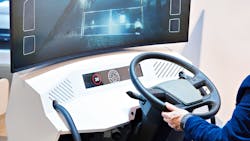Will machines teach the next generation of truck drivers?
Traditional styles of learning and training—think sitting in a classroom with an instructor leading the discussion—have taken a back seat over the past year, opening the doors for more remote learning and training opportunities. While traditional learning and training models will likely stick around, advancements in artificial intelligence (AI) and machine learning are allowing for a more blended approach to truck driver training.
Today, the average driver is 55 years old and male, with many approaching retirement. According to the American Trucking Associations (ATA), over the next decade, the industry will need to hire roughly 1.1 million new drivers, or an average of nearly 110,000 per year. Replacing retiring truck drivers will be the largest factor, accounting for 54% of new driver hires, ATA noted. The second largest factor will be industry growth, accounting for 25% of new driver hires.
During a recent press conference, John Kearney, founder and CEO of Advanced Training Systems (ATS), described how simulators can help train the next generation of truck drivers. ATS is a simulator technology and engineering firm that designs advanced training systems to improve training for truck drivers.
Younger drivers coming up in the industry are aware of and have shown greater interest in using simulation in their training, Kearney explained. “If you introduce them to a classroom and a textbook, they probably will leave that company and not continue,” he added. “But if you introduce them to what we have today in the training field, then they are more likely to want to be a part of that process and grow in this industry.”
Kearney, who has spent more than 30 years in the driver training field, has brought simulation as a training tool to multiple schools throughout the U.S.
“Part of the training with simulators is that you would learn to drive a real truck, but it would be after you learn to drive on a simulator,” Kearney said. “If you drive in a real truck, you have all sorts of costs for operating that vehicle and you also have the risk of having an accident.”
Keeping it relevant
For the past seven years, Luma, an instructional design and learning company has focused on developing teaching strategies for the trucking and transportation industry. Luma provides tools to help trucking companies leverage their expertise to create content that is most authentic for their drivers, explained Gina Anderson, Luma co-founder and CEO.
“As we all know in the trucking industry, recruitment and retention is so important,” Anderson said. “We see the ability to leverage technology and learning to be able to support and inherently help the retainment of drivers. We look at three things primarily: The content, the tools or the platform, and the delivery.
“For adult learning, if you can make something relevant to the learner, it will have the most impact to be able to retain their attention. We look at the content specifically and the tools for that,” she added.Anderson also pointed out that more than 86% of Luma participants use tablets and mobiles devices for their training. Commercial drivers can also access training through their electronic logging devices.
Britton Transport, a subsidiary of Bison Transport, began using Luma’s eNugget learning management system (LMS) in January 2020. The LMS comes with a collection of some 600 customizable learning modules that cover driver safety, compliance, and orientation topics with content in mixed media. Luma’s eNuggets are meant to be short and more like on-demand microlearning lessons for commercial drivers.
Britton, a Grand Forks, N.D.-based company that operates 150 tractors that power a fleet of dry van, flatbed, and refrigerated trailers, was able to compress driver orientation time by more than 50%, eliminate paperwork, hold drivers more accountable, and accommodate driver needs through Luma eNuggets.
Britton’s safety specialist, Hannah Defever, noted that drivers previously spent up to 15 hours to complete training assignments for orientation and wasted time re-watching videos. Drivers can now complete an orientation packet of Luma eNuggets in less than seven hours.
Starting in March 2020, Britton also began giving drivers the option to complete orientation training remotely. Drivers can complete the orientation program using mobile devices, and through Luma, Defever created a “pace yourself” option that allows drivers to complete orientation training at home and take a drug test remotely.
In addition to streamlining orientation processes, fleets can use eNuggets to receive a report of how their drivers are rating their training content. Those real-time analytics can help fleet management decide on future content and learning tools.
“Drivers will spend more time on the content if it is more game based,” Anderson explained. “If you have a combination of content that has specific carrier policies and information coupled with the interactive nature of game-based education, the drivers spend more time and rate them very high.”
Fleet managers have also been using in-cab video to coach drivers when needed. Britton uses the Luma eNugget LMS to assign remedial training when drivers are involved in accidents or have critical safety events.
Kearney has also seen fleets use technology and simulators to address safety issues and other potential problems that come up among drivers.
“There are still a lot of people who will say , 'I don’t think I need that; we’ve been doing it this way forever,'” he explained. “You do have some apprehension to using simulators. Some driver trainers are afraid that they won’t have a job, which is totally untrue. What it really does is advances the things that they can do in the training field, so they can be more sophisticated in what they do and better trained.”
About the Author

Cristina Commendatore
Cristina Commendatore is a past FleetOwner editor-in-chief. She wrote for the publication from 2015 to 2023.

